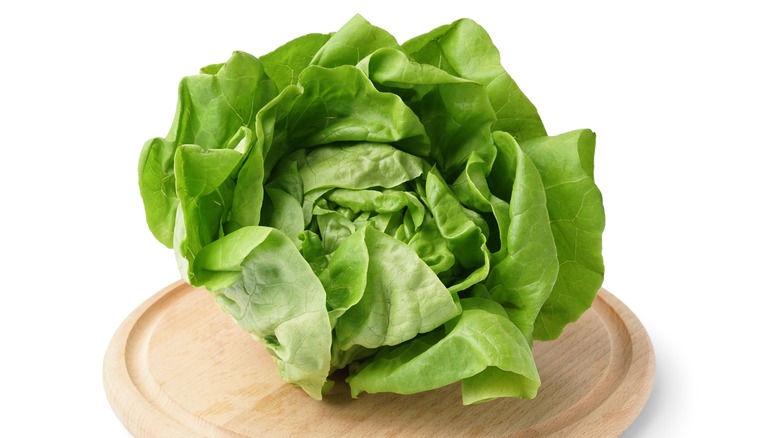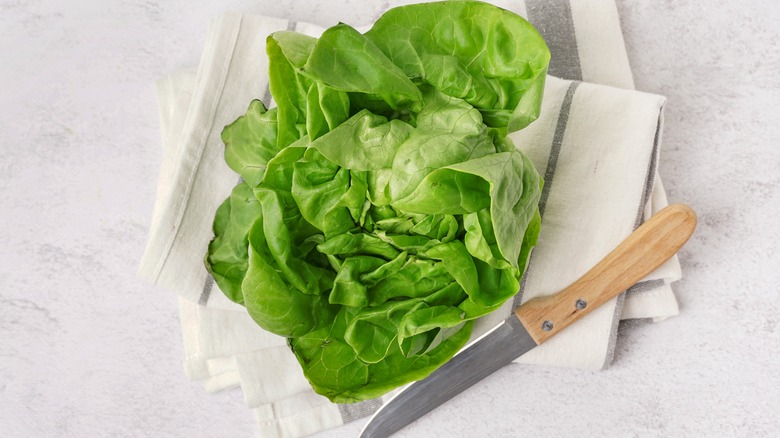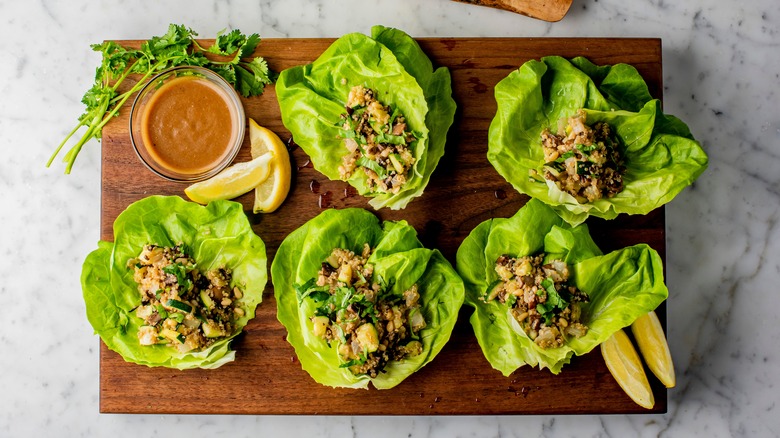The Main Difference Between Bibb And Boston Lettuce
Of the many commonly available lettuce varieties out there, it's likely that your local supermarket sells a few types categorized as butterhead lettuce. This collection of greens, suitable to star in salads or boost sandwiches, provide loads of iron and Vitamin A, are sturdy in composition but light in texture, and bring a notably buttery through-line and hints of sweetness with zero bitterness. Butterhead styles are considered soft lettuces — ones that don't require much massaging to work out the toughness before use in a salad.
Among the most commonly cultivated and consumed of the butterheads, respectively, are Bibb and Boston lettuces. These two varietals pack a similar taste and boast a nearly identical mouthfeel, and they can serve similar culinary purposes. But there are a few key differences between Bibb and Boston butterhead lettuces, and they're primarily cosmetic. Look closely and you'll see that Bibb and Boston vary several ways in their respective appearance.
Boston lettuce leaves are bigger and more green than Bibb leaves
Founding father Thomas Jefferson reportedly grew more than a dozen types of lettuce at his Monticello estate in Virginia, including the precursor to what is today called Boston lettuce. One of Jefferson's preferred kinds was Green Capuchin, which, like the Boston lettuce it would evolve into, matured into medium to large-sized heads of loosely arranged, very light green-colored. and widely shaped leaves that promised a sweet, buttery flavor. Boston lettuce predates Bibb lettuce, because the latter is a version of the former.
John Bibb, a War of 1812 veteran and Kentucky state legislator, lettuce at his home in Frankfort. He originally called his 1860s creation limestone lettuce, but it wouldn't be widely available and popular until more than 100 years later, when it would bear its cultivator's name. (Confusingly, Bibb lettuce is also sometimes known as Boston Bibb lettuce.)
One major difference between Bibb lettuce and Boston lettuce is that the former's heads typically grow smaller and more narrow than the latter's, with a tighter presentation of shorter leaves. Bibb leaves also tend to finish in a slighter darker shade of green than its light-green cousin. Bibb can be tender to the point of frangibility, and special care is necessary to make sure that butter lettuce stays fresh.
Boston and Bibb lettuce have particular uses in the kitchen
Despite their differences, Boston and Bibb lettuces can, generally speaking, be used interchangeably in dishes. Both varieties can withstand a lot of weight, which makes either Boston or Bibb suitable shell alternatives for dishes like low-carbohydrate tacos. The faintly oily and subtly sweet taste off these butter lettuces complement strong and savory tastes, while also serving a functionary purpose as the outer layer of a lettuce wrap. And because of its cup-like form, a butter varietal like Boston or Bibb is a good choice for lettuce wraps packing everything from tofu and mushrooms to marinated steak to Buffalo chicken.
While they're great as a shell substitute, butter lettuces are tasty on their own when served raw, and the leaves aren't too tough to chew or leave an aftertaste. Boston and Bibb lettuces can star in a light salad, their natural sweetness pairing well with fattier, intensely flavored elements, like blue cheese or pecans. Whether it's Boston lettuce or Bibb, these butterhead lettuces don't require a ton of fuss — a true asset for any home cook.


